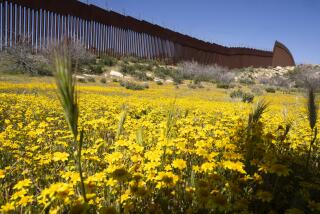Tiny Agency Keeps Border Use in Line
- Share via
The International Boundary Commission is almost the smallest agency in the United States government. In Canada, its counterpart is the tiniest bureaucracy.
But the two commissioners who serve on the panel, David C. Fischer of the United States and Alec McEwen of Canada, are charged with maintaining the longest undefended border in the world.
The 5,526 miles shared by North America’s two largest democracies equals the distance from London to Cape Town, South Africa; or from Seattle to Shanghai. It is marked by more than 8,000 monuments.
The formal boundary dates from the early 1800s, when the United States and Great Britain, which owned Canada, agreed to crude survey lines. Most of the border is the 49th Parallel, except along the Great Lakes and Alaska. The first survey was completed in 1874; the latest was done with satellite technology. Even today, the commission is considering more accurate mapping.
A 1908 treaty established the panel, and further diplomatic fine-tuning has charged it with maintaining “at all times an effective boundary line. . . .”
Wrangling sometimes occurs over interpretation of “effective,” but lawyers for both countries interpret it as an open swath, or a well-marked area, running the entire length of the border.
Inspection, repair of monuments and buoys, relocation and reconstruction of damaged markers, and above all, keeping open a “skyline vista,” constitutes most of the panel’s responsibility.
Appeal Rejected
Commissioners recently rejected an appeal by Waterton-Glacier International Peace Park officials to waive the clear-cut regulation. The panel said it did not have authority to disregard a treaty approved by Congress and Parliament. The commissioners also said they did not want to set a precedent.
McEwen said the commissioners’ job was “to say where the boundary is on the face of the Earth.”
60-Foot Jurisdiction
The cleared strip along the boundary is 20 feet wide, although the commission claims jurisdiction over 60 feet, half on each side.
Some areas, such as Maine’s thick timber, must be cleared every six years. Other stretches, such as the rugged Alaska-Canada border, take as long as seven years to clear because of the effort and great expense involved in keeping the vista open.
About 1,500 miles of the border must be cleared of brush and trees. Where there are no trees, rock cairns and concrete monuments distinguish the border.
The treaty forbids obstruction or building within the 20-foot boundary vista. Structures in place when the treaty was signed may not be enlarged without the commissioners’ consent.
About 100 so-called line houses had been erected directly on the boundary before the treaty. Many were built for illegal purposes, mostly smuggling.
More to Read
Sign up for Essential California
The most important California stories and recommendations in your inbox every morning.
You may occasionally receive promotional content from the Los Angeles Times.













